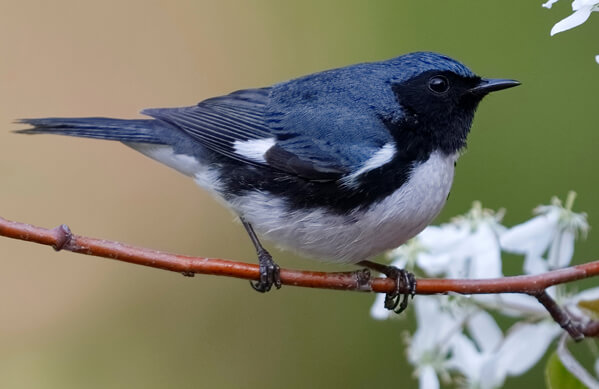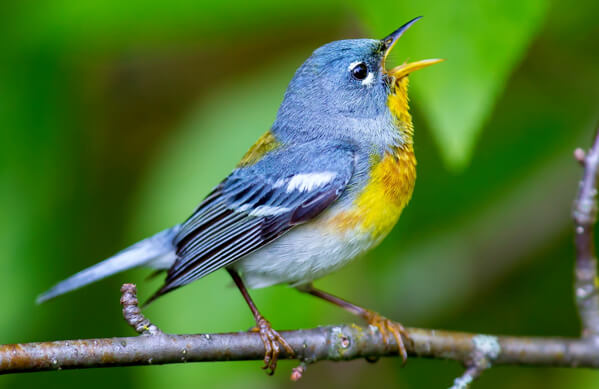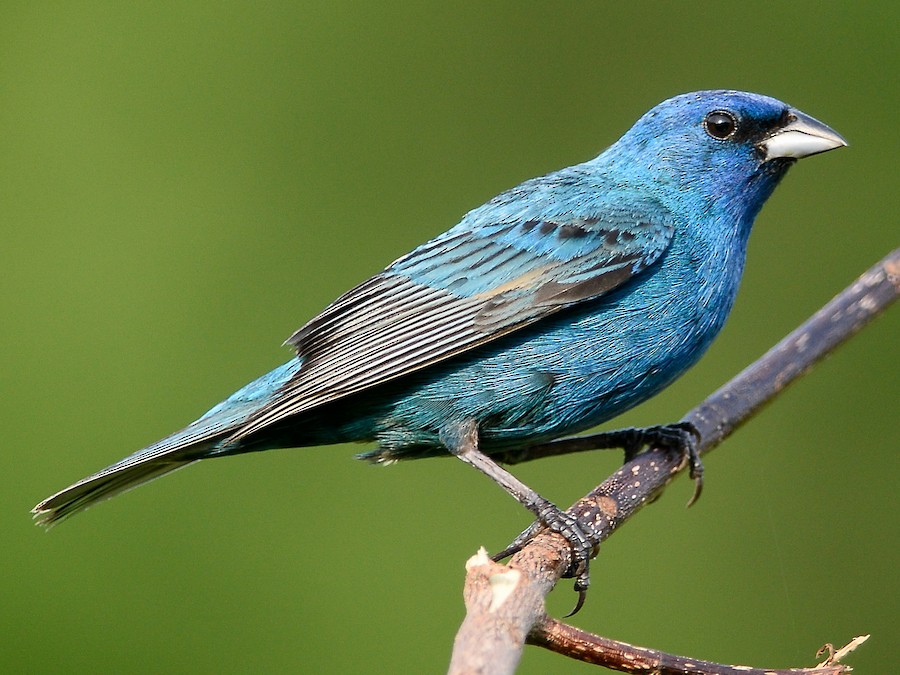With thousands of known bird species across the world, there’s no doubt that they come in just about any type of shape or color you can imagine. As you might have already seen in some of our other articles, even an extremely specific coloration at one location can be shared by a large number of birds.
In this article, we’ll be going over 15 blue birds that are found specifically in the state of Michigan.
1. Blue Jay
Scientific Name: Cyanocitta cristata
Range: United States, South and Central Canada
The blue jay is a brilliant and common jay that consists of bright blue plumage above and pale gray plumage below with a fuzzy crest. They have a black ring of feathers around their neck that extends down to the breast, along with black and white markings on the wings and tail. Males and females look similar.
Typical habitats for the blue jay, from southern pine woods to northern spruce-fir forests, vary extensively over their large range. Preferred habitats often include mixed wood and deciduous forest areas, especially those containing beech, hazel, and oak trees. They are overall less abundant in heavier forests. They are known to visit bird feeders.
As omnivores, blue jays have quite an extensive diet, which mainly consists of acorns, nuts, grain, fruits, bread, meat, small invertebrates, and the eggs and nestlings of other birds. Keep in mind that this list is by no means exhaustive, and their diet can include many other types of animals and plants.
2. Blue-Grey Gnatcatcher

Scientific Name: Polioptila caerulea
Range: United States, Central America, rarely in Southern Canada
The blue-grey gnatcatcher is a small songbird consisting of a small thin beak, blue-gray plumage above, whitish plumage below, thin white eye rings, and a long tail. Breeding males tend to have a black band across their foreheads. Compared with the black-tailed gnatcatcher, this bird has a mainly white tail with small amounts of white. This bird may also be confused with the black-capped gnatcatcher, though the former has a higher-pitched call.
The blue-grey gnatcatcher can be separated into two distinct populations, with the eastern population often breeding in deciduous woodlands near water and the western population drier, brushier habitats. Both populations winter from the southern U.S. to northern Central America.
The typical diet of the blue-grey gnatcatcher mainly consists of small insects, their eggs, and spiders. Caterpillars and gnats also make up a large majority of their diet, though the exact prey will depend on what insects are around their immediate vicinity.
3. Tree Swallow
Scientific Name: Tachycineta bicolor
Range: North and Central America
The tree swallow is a medium-sized swallow with bright white underparts. Adult males consist of an iridescent blue-green plumage above, while females and juveniles are of a duller brownish color with little or no iridescence. They are overall quite compact in shape, with broad wings and a slightly notched tail.
The tree swallow can be found in a variety of open habitats, such as grassy fields, lakes, marshes, ponds, and other places near water sources. They breed in tree cavities and artificial ones, such as human-made nest boxes.
Tree swallows mainly feed on flying insects, but they also consume more berries, fruit, and seeds compared to other swallows. Common insects include midges, mosquitoes, flies, beetles, and moths. They may also consume other small animals, such as spiders and mollusks.
4. Eastern Bluebird
Scientific Name: Sialia sialis
Range: United States, Southern Canada, Central America
The eastern bluebird is a small migratory thrush with adult males having a bright royal blue plumage above with an equally bright orange throat and breast, and a brilliant white belly. Females are paler overall with less blue, instead being more grayish with some orange on the breast and sides of the neck, along with a white belly. Juveniles tend to have a pale blue plumage like females, but with a less developed orange breast.
The eastern bluebird’s habitat usually consists of open country containing patchy vegetation and large trees, examples being meadows, old fields, and golf courses. They can often be found perching on wires or fence posts. They nest in cavities, both natural and artificial (i.e., nest boxes).
The eastern bluebird feeds mainly on insects and berries. Insects vary quite a bit, but can often include crickets, grasshoppers, beetles, among others. Other live prey includes spiders, earthworms, snails, and the occasional small lizard or tree frog. Berries are usually eaten during winter.
5. Indigo Bunting
Scientific Name: Passerina cyanea
Range: United States, Southern Canada, Central America
The indigo bunting is a small bird with breeding males having an entirely blue body with a somewhat darker head. Females are plain brown throughout, with a white throat, blueish tail, and pale streaks on the underparts. Though their range doesn’t really overlap, the female indigo bunting can often be confused with the female lazuli bunting, though the former has more streaks on the underparts, has fainter wing bars, and duller breast, and a brighter throat.
The indigo bunting breeds in shrubby areas near the edges of forests and fields and will winter in weedy fields, mainly throughout Central America and the Caribbean. The males can often be found singing from a high perch.
The indigo bunting feeds mainly on a variety of berry-producing plants, with their favorites often being strawberries, blackberries, serviceberries, blueberries, and elderberries. With these plants also come the insects that are attracted to them, such as beetles, grasshoppers, aphids, and cicadas, which the indigo bunting will also gladly eat.
6. Purple Martin
Scientific Name: Progne subis
Range: United States, Central Canada, Central America, Scattered in South America
The purple martin is a large swallow (the largest one in Mexico) with adult males consisting of dark purple-blue iridescent plumage throughout, which is visible at a close-up view. Females are grayer, with some iridescence on the crown and back and various splotches on the underparts. Juveniles lack the purple color and have a white belly.
Purple martins may inhabit both urban and rural areas, with them especially preferring open, grassy areas and forest openings adjacent to streams, rivers, marshes, ponds, or lakes. They nest primarily in nest boxes and martin houses, but also uses natural cavities in the western U.S. and Mexico.
Purple martins are mainly insectivorous, meaning they feed primarily on flying insects, such as moths, gnats, flies, wasps, and mosquitoes. Dragonflies make up a large portion of their diet. They typically catch their prey in midair and can drink in midair as well while flying over a water source.
7. Cerulean Warbler

Scientific Name: Setophaga cerulea
Range: Midwestern and Eastern United States, Central America, Northeastern South America
The cerulean warbler is a bright blue warbler that, for males, has light blue plumage with dark blue and black streaks above, a white throat and belly, and a thin necklace. Females consist of a dull turquoise color with pale eyebrows and blurry streaks on the sides. Juveniles have a yellow wash on their underparts. All have bright white wingbars.
Cerulean warblers tend to breed in large tracts of older deciduous forests consisting of tall trees. They tend to nest on the north and east-facing slopes of the Appalachian Mountains, and prefer any gaps or openings in the canopy. Because they often stay high up in the canopy, their blue coloration can be difficult to spot. They spend their winters mainly on the east slope of the Andes.
As insectivores, the cerulean warbler feeds mainly on insects, such as flies, beetles, weevils, and caterpillars. They may also consume some plant matter, including nectar, during non-breeding seasons and winter. Juveniles are usually fed butterfly larvae.
8. Belted Kingfisher
Scientific Name: Megaceryle alcyon
Range: North and Central America
The belted kingfisher is a heavy-built water kingfisher with a shaggy crest on top of a rather large head, and a long, straight, thick beak. Males are a grayish-blue color above with white underparts and a blue breast band. Females appear similar with the exception of an additional rusty-colored band across the belly.
The belted kingfisher can be found near streams, rivers, ponds, lakes, and estuaries, where there is an abundance of trees that the bird can use to perch on and spy on fish from above. They also nest in burrows along or straight over the water so that they can be near their prey.
Small fish, such as sticklebacks, mummichogs, trout, and stonerollers, make up the majority of the belted kingfisher’s diet. In addition, the bird will also feed on other aquatic animals, such as crayfish, mollusks, small amphibians, and insects by diving after them, if given the chance. They may occasionally consume berries.
9. Great Blue Heron

Scientific Name: Ardea herodias
Range: United States, Southern and Central Canada, Central America, Ecuador, Colombia, Venezuela
The great blue heron is a large heron with an overall gray body, blue wings, a large yellow-orange beak, small black plumes on its head, and a black and chestnut-colored pattern on its shoulders. Juveniles are browner than adults, and have a dark crown. They have a separate population (known as their “white form” or sometimes the “great white heron”) in southern Florida and the Caribbean.
The usual habitats for the great blue heron include almost any wetland area, such as small ponds, marshes, lakes, rivers, and saltwater bays. Their nesting sites require tall trees; hence they’re often found in wooded swamps or on islands safe from predators.
The great blue heron’s diet consists mainly of small fish, though they’ve also been observed consuming other aquatic life, such as shrimp, crabs, aquatic insects, small mammals, amphibians, reptiles, and other birds. They typically locate their food by sight and will swallow them whole.
10. Black-Throated Blue Warbler

Scientific Name: Setophaga caerulescens
Range: United States, Southern Canada, rarely in Central America
The black-throated blue warbler is a small passerine bird that displays clear sexual dimorphism; the males have a unique deep blue plumage above with a black face and sides, along with a white belly, while females are a plain brown color with lighter brown underparts and a pale face. Both genders have a small white patch on the wings, a trait only absent on a few juvenile females.
The black-throated blue warbler breeds in the undergrowth of mixed forests, in which the bird especially prefers hills containing dense vegetation. During migration, these birds may be found in almost any wooded or shrubby habitat. They spend most of their winters in the Caribbean.
The black-throated blue warbler feeds primarily on spiders, flies, and caterpillars, which they find under leaves and twigs in the shrub layer and lower canopy. They are very fond of Lepidoptera adults and larvae. During the winter, they will supplement their diet with fruits as insects become scarcer.
11. Barn Swallow

Scientific Name: Hirundo rustica
Range: All continents except Australia and Antarctica
The barn swallow is a large swallow identifiable by its long, forked tail and dark rump. It has an iridescent dark blue plumage above with a dark orange throat and forehead. Its underparts, which may appear anywhere from brown-orange to white, depending on the bird’s range. Its head and breast pattern, along with its tail length, help to distinguish this bird from other similar swallow species across Africa, Asia, and Australia.
Typical habitats for the barn swallow include open areas of any kind, such as pasture, meadows, farmland, and other places preferably near water. Per their namesake, this bird is commonly found in barns or other outbuildings. They can nest in any place that contains open areas for foraging, a water source, and a sheltered ledge where they can build their nest.
Barn swallows feed on many flying insects, such as flies, beetles, wasps, wild bees, and true bugs. Other insects include moths, damselflies, grasshoppers, among others. They may also consume spiders and snails if they come across them, along with the occasional berry or seed.
12. White-Breasted Nuthatch
Scientific Name: Sitta carolinensis
Range: North and Central America
The white-breasted nuthatch is a large nuthatch with a white face, a black cap, blue-gray upperparts, and a rusty colored belly and undertail coverts. Females have a somewhat paler crown compared to that of males. The appearance, especially that of the darkness of the sides and back, the width of the black crown, and the vocalizations, may differ across their range.
The white-breasted nuthatch can be found in forests, woodlots, groves, and shade trees. They are often seen in mature deciduous forests and mixed forests containing conifers. They are rarely found in pure coniferous forests. They may also be found in more suburban areas, such as alongside roads and in parks, where large trees are present.
The white-breasted nuthatch feeds mainly on insects and spiders during the summer while supplementing them with seeds during winter. Seeds can be nonexistent in their diet while consisting up to 60% during winter. They may also feed on suet and peanut-butter at bird feeders. Juveniles are fed on insects and spiders.
13. Northern Parula

Scientific Name: Setophaga americana
Range: Southern Canada, United States, Central America
The northern parula is a small colorful warbler with a sharp, bicolored beak, blue-gray plumage above with a yellow-green patch on the back, white eye-arcs, and a yellow breast. Adult males have a distinctive black and reddish-brown band across their breasts, while juvenile females are plain yellow in overall color.
Northern parulas breed in mature forests alongside streams, swamps, and other types of bottomlands. They build their nests using moss, hence why they can often be found near moss or lichen that grow on the branches of canopy trees. They may be found in almost any wooded habitat during migration.
The northern parula’s diet consists mainly of insects, such as small beetles, flies, moths, caterpillars, true bugs, ants, and wasps, among others. They may also consume spiders or small berries if they encounter them. Soft green insect larvae are often fed to nestlings.
14. Common Grackle
Scientific Name: Quiscalus quiscula
Range: North America, occasionally in northern Mexico
The common grackle is a slender, glossy blackbird that is slightly larger than a jay but smaller, longer-tailed, and shorter-winged than a crow. It has an iridescent blue head, wings, and tail, a green back and breast, pale yellow eyes, and a long and sturdy beak, similar to that of the red-winged blackbird.
Common grackles may be found in wet, open woodland and marshes, as well as in suburbs, parks, and agricultural fields. They often build their nests near water sources, and are known visitors of bird feeders.
Common grackles often feed on invertebrates and mice, small fish, leeches, earthworms, bird eggs, and juvenile and adult birds. These birds are very resourceful and can catch their prey using a variety of methods depending on what they’re looking for (i.e. they may follow plows to catch mice, steal worms from American Robins, or raid nests to consume eggs). They are also known to eat seeds, especially sunflower seeds, acorns, and sweetgum.
15. Brown-Headed Cowbird
Scientific Name: Molothrus ater
Range: North America, Mexico
The brown-headed cowbird is a small icterid with a short tail, a thickset body, and a stout beak. Males are a glossy blue color with a light brown head, while females are gray-brown overall without any bold streaks, and with a paler throat. Male juveniles are mainly colored in an iridescent black plumage with light brown patches throughout, while female juveniles are brown throughout.
The brown-headed cowbird’s habitats include grasslands with low, scattered trees, woodland edges, brushy thickets, prairies, fields, pastures, orchards, and some residential areas. They are known visitors of bird feeders. These birds are usually an unwelcome sight due to their parasitic nature in which they lay their eggs in the nests of other birds.
The brown-headed cowbird consumes mainly seeds and insects, with seeds (especially those of grasses, weeds, and waste grain) making up roughly half of their diet in the summer and over 90% in the winter. Insects, such as grasshoppers, beetles, and caterpillars, as well as spiders and millipedes, make up the rest of their diet.
Conclusion
Birds are some of the most diverse animals on Earth, and as you can see, with something as specific as blue birds in Michigan, we can come up with numerous species that fit the bill. Thanks to their blue appearance, most of these birds can be seen quite clearly on their own, as long as you know where to look.
Related articles:
17 White Birds in Hawaii to Spark Your Aloha Spirit










